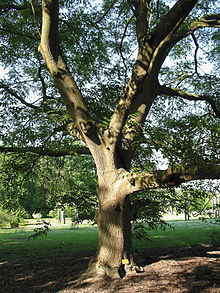Japanese walnut
| Japanese walnut | ||||||||||||
|---|---|---|---|---|---|---|---|---|---|---|---|---|

Japanese walnut ( Juglans ailantifolia ) |
||||||||||||
| Systematics | ||||||||||||
|
||||||||||||
| Scientific name | ||||||||||||
| Juglans ailantifolia | ||||||||||||
| Carrière |
The Japanese walnut ( Juglans ailantifolia ), also called Siebold's walnut , is a deciduous tree native to Japan from the walnut genus ( Juglans ) in the walnut family (Juglandaceae).
distribution
The homeland of the Japanese walnut is in Japan and Sakhalin . It is often planted in the northeastern United States to replace butternut stocks, which are indigenous to the region and have been severely damaged by a fungal disease caused by the Sirococcus clavigigenti-juglandacearum fungus. The Japanese walnut is immune to this fungal disease. The tree is rarely seen in Central Europe .
description
As a tree, the Japanese walnut grows to a height of about 18 or more meters. It is a deciduous deciduous tree , the bark is brownish-gray or brownish with age and has shallow furrows.
The pinnate leaves are very large for walnuts with a length of 80 to 100 cm; they have 11 to 17 leaflets . The young twigs and the leaf spindle are short but densely hairy; the hair is dark reddish and sticky. The leaflets are almost bare on the upper side, but hairy on the underside, mainly on the nerves. The leaflets are finely serrated and glossy green on top, the individual leaflets are 7 to 16 cm long and 3 to 5 cm wide.
The male flowers catkins are 13 to 30 cm long. The female flowers appear in June on upright inflorescences about 10 cm long . The fruits are spherical to ovate, thick and sticky hairy; they are usually grouped in groups of 4 to 10, and the approximately 3.5 to 5 cm large nuts are tasty. The nuts are slightly pitted and ribbed, flattened ovoid to slightly heart-shaped and pointed.
use
The wood is light and of lower quality than that of the real walnut , but is also used for furniture.
Systematics
The first description under the name Juglans ailantifolia comes from the French botanist Élie Abel Carrière and was published in 1878.
There are two varieties:
- Juglans ailantifolia var. Ailantifolia ( Syn. : Juglans cordiformis . Var ailantifolia ( . Carr ) Rehd. , Juglans sieboldiana Maxim. )
- Juglans ailantifolia var. Cordiformis (Makino) Rehder (Syn .: Juglans coarctata Dode , Juglans cordiformis Maxim. , Juglans lavalleei Dode , Juglans sieboldiana var. Cordiformis Makino , Juglans subcordiformis Dode ).
The Japanese walnut often hybridizes (especially in North America ) with the closely related butternut ; the hybrids are called Juglans × bisbyi Rehd. designated.
swell
- Alan Mitchell, translated and edited by Gerd Krüssmann: The forest and park trees of Europe: An identification book for dendrologists and nature lovers . Paul Parey, Hamburg and Berlin 1975, ISBN 3-490-05918-2 .
Single references
- ^ Rev. Hort. (Paris) 50: 414, fig. 85-86. 1878.
- ↑ See entry at GRIN Taxonomy for Plants .

